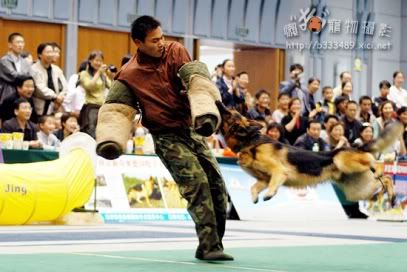 | Home | About Us | Males | Females | For Sale | Articles | Books | Sieger Show Tour | Contact Us | Links | |
by Fred Lanting |
© Copyright December, 2005 - |
Before we get into the description of how the courage test is performed and why it is needed, you should know something about “where I’m coming from”. My first GSD in 1947, in New Jersey, was an “immigrant” or the son of an import — unfortunately, all records were lost. I had many GSDs since then, both “German” and “AKC” lines, mostly the former. I have owned offspring of Gin Lierberg, Uran Wildsteigerland, Lance of Fran-Jo, Timo Berrekasten, grandsons of Cello Romerau, Bernd Kallengarten, and many more. I have trained innumerable dogs for myself and others in AKC-type obedience as well as Schutzhund (all of them so-called “show-dogs”), and am a member of the somewhat elite USA SchH-3 Club. As a professional handler I have put championships and high V-ratings on many dogs. I have had hundreds of puppies, and many years experience as a canine behaviorist and consultant. I have judged and lectured in some 30 countries and have seen the gamut of training and club requirements for shows and bre
eding. I am the author of “The Total German Shepherd Dog” as well as several other books. Not bragging, just saying how blessed I’ve been in this sport. Sometimes one has to re-establish one’s credentials, because the nature of the dog sport is that there are perpetually novices added to its ranks who don’t know us old-timers, and there are also “perpetual novices” who’ve been around a long time but still “don’t get it”. With this background, and a long history of conducting annual tours of Europe centered on the Sieger Show, and including visits to trainers and training clubs, I don’t think there are many still active who have as much exposure to the breed in all its facets. I believe firmly that von Stephanitz’ dream of the total dog should continue to be respected. My ideal (and I’ve owned several examples) is the “golden middle” that can make me happy in both anatomy and character, both gait and performance. And so I emphasize to my tour groups the importance of seeing for yourself the character demonstrated by the conformation competitors, the preliminary and prerequisite courage test being held on the first day, Friday. Those that pass can then go to the next part of the grounds for the standing exam and gaiting, with the preliminary ranking assigned at that time. Those that do not meet the minimum performance standards go back to their dog trailers and sit out the rest of the show weekend, then home
for better training or for sale to a country like India, Australia, or another where the test is not required, or where it is thought it might be easier to pass it. There aren’t many of those anymore. There are two exercises that make up the courage test, being excerpts and modifications from the Schutzhund Phase C (protection) routine. There is a little bit more leniency, with the judges a little more forgiving in regard to correct heeling, number of times the “Out!” command is allowed, and how close the handler gets to the dog before yelling it, but basically, the worst passing performances resemble the work of the lowest-scoring dogs in a regular schutzhund trial. It should be said somewhere that there are different terms for this SchH title, ranging from VPG to IP or IPO, but it will be a long time before trainers lose the traditional name of the sport. The first half of the test is the “attack (on handler) from the blind”, and the second part is the “long attack”. Come with us, now, as we (a team of handler and dog) do the exercises at such a show. First, a few teams are lined up outside the large field, which is usually about the size of half or ¾ of a soccer field, waiting their turns. As the preceding team exits via a different gate, and the judge announces their status as “pass” or “fail” and (if they pass) whether the dog was “pronounced” (ausgeprägt) or just barely “present” (vorhanden), the next team walks to the starting point. The judge gives an indication that he is ready for them to begin, and the handler heels his dog to the next marker, at least five paces from the first blind that is a bit to one side, stops with dog sitting, and removes the leash. There is a helper (“bad guy”) hiding in the blind, which of course the dog fully knows, but is supposed to act surprised when the helper pops out in a very threatening attack on the handler. The team, upon a nod or gesture from the judge, starts heeling off-lead in the general direction of the blind. Most dogs that properly continue heeling show considerable desire to leave when the opportunity (threat) appears; in fact, most will eagerly crouch with lowered head as they heel, because by thus lowering the center of gravity, they can spring forward with more power and initial speed when that happens. As they get near, the attacker runs out, waving his stick (and usually being noisy). The dog immediately, without any command being needed from the handler, charges at the bad guy to intercept him and thereby protect his master. The bite on the sleeve should be immediate and convincing, and when the struggle ends, the dog is to release, with no more than 3 commands allowed (including the dog’s name). The count on the “commands” is frequently a little bit flexible. After the dog outs, the handler is permitted to walk up to them and retrieve (heel off with) his dog. He heels to the far end of the field while helper #1 disappears. When the team gets to the marker at the end, they turn and face the originating part of the exercises. From another far part of the field, helper #2 trots along, while the handler shouts at him to get off his property, turns toward the dog-handler team and starts running fast and furiously, again with threatening shouts and stick-waving. The handler releases his seated, eager dog, the dog tears down the field and flies through the air at the end, to hit the helper and latch onto the sleeve. The good helper knows how to catch the dog by “giving”, the way a baseball player catches a fast pitch so he does not have a hard impact. The most applause comes when a hard-hitting dog is caught high and swung around in the air to be set down relatively gently on the ground behind the helper. That shows really pronounced drive and enjoyment of the work. Again, the struggle stops, the dog releases with (usually) or without command. I like to train my dogs to “out” on their own when the fight stops, without a command from me. Some handlers have to scream at the top of their lungs, hoping the dog remembers how to count up to three and then obey. Then the judge allows the handler to approach the helper and retrieve his dog. In the courage test, there are many irregularities or straying from perfection that would cost the schutzhund trial competitor several points, but here it is just pass or fail. If the work is not convincing, if the dog is weak or reluctant, he may get a “vorhanden”, meaning he can only get an SG (very good) in the conformation show, not a V (excellent). There are two photos I sent with this article that show something you might not notice at first glance. Andrew’s “Little Man” (Unesco) is doing the “first-half” of the protection exercise with one helper, and the back-half with a different helper. The first one is left-handed, so he wears a sleeve on his right arm, something very few dogs get a chance to see. It was a surprise to many dogs who are used to coming at an attacker from a certain direction and the threat coming out of their left side of the blind. Most adjusted very quickly to the “strange” arm being presented. After the German Sieger Show tour that I led (an annual event for me) a professional photographer gave me permission to use some of his excellent shots. Very incidentally, part of my tour group was in the background in the stadium in many of them. In one picture, I’ve outlined in white where we were sitting; the dog is just on the verge of letting go as the struggle has just stopped. Credit for these stadium shots: Franck Haymann, www.aniwa.com. One more picture might be included, at your editor’s pleasure: a working police department dog in Nanjing, China, where I judged a couple of shows in 2004, is properly and safely caught by a military helper and is being set down. You can see that there is very definitely a practical aspect and history to the courage test as it is carried out in a similar though more formalized manner than in real-life police or military situations. In the very few places where courage is not tested or thought to be a requirement for a breedable GSD, this very practical aspect of breed selection (suitability for service in police, military, or personal protection) is kept at arm’s length by the people in charge of the show-line dogs. In Australia and its smaller copycat New Zealand, the officials of the GSDCA (GSD Club of Australia) are afraid of government repression and the threat of mandatory neutering (as had been the law not that many years ago when there was a breed ban on the GSD). They are ruled by the ANKC (Australian National Kennel Council), a quasi-governmental body heavily controlled by national politicians. The State politicians also get into the act, adding their own repressive anti-dog, anti-sport laws on a more local level. Many feel it is a case of the tail wagging the dog, and instead of the government being the servant of a free people, it is the master instead, able to dictate more severe limits on individual liber
ties than in some other countries. But as long as the citizens vote for such “governors”, they deserve what they get. Europe has long been sliding in the direction of less freedom for dog owners, and America is also slipping in that direction, though still far behind. What is the purpose of the courage test in today’s societies? If you acknowledge that character is historically the primary feature of the German Shepherd Dog, the answer is obvious: it is to provide a proofing tool (that’s what the word prüfung means) to weed out the weakest temperaments and least useful individuals, and by such population genetic pressure, maintain the true German Shepherd Dog. We don’t expect every GSD to be used in police or military work, but neither should it degenerate into a foo-foo breed and lose its identity. Even before Europe’s growth of cities, decline in wolf and other predators, and less need for sheep herding, von Stephanitz established the breed as the preeminent guard and protection dog for families as well as for all manner of civil and official work, from customs and border patrol to searching for lost children or escaped criminals. History has shown that degeneration in such working character follows the lack of genetic selection pressure for the necess
ary traits. The courage test is primarily an exercise in obedience with willingness and ability to defend the owner. In fact, the whole schutzhund routine is more an obedience test and demonstration than a show of biting or fighting. What is the future of “protection as selection”? Mostly downhill, thanks to non-dog-owners being elected to political office. But, in the USA there is a movement called “My Dog Votes” (no spaces between words, if you are doing a Google search) with citizens of all political stripes uniting to campaign against politicians who pass laws that are detrimental to the full enjoyment of dog ownership, including the highly rewarding and satisfying sports represented by schutzhund. The anti-dog forces of PETA and HSUS are well financed by air-headed celebrities with more dollars than sense, and it will be a long, bitter battle. In Europe, Australasia (Oz and NZ), and individual communities in the U.S., there are breed-specific laws written by idiots who don’t understand the first thing about dogs, human nature, or logic. National and State laws (and lawmakers) must be traded in for better ones. As one friend from the land of Oz told me, “Our people cannot tell the ANKC to go away, or they would not be allowed to show any of these dogs in the regular conformation ring (as opposed to the Main Breeds ring).” I don’t quite understand the difference between those two, despite having judged numerous times Downunder. Continuing with the quote: “We believe it is very important that top-quality GSDs also appear in the regular conformation classes whenever we can tempt their owners to enter them. Otherwise the divide [between show and working/sport dogs] becomes even wider. Not many of them bother of course, but those that do are much valued and give us an idea of where the breed stands –interestingly enough, many of them do enjoy the ‘ordinary’ shows once they try them.” This was in response to my partly tongue-in-cheek suggestion that “Your GSD folks should just tell the ANKC to go away, and join the WUSV instead (
whole-heartedly).” Right now, the GSDCA in Australia is resisting being a member in more than just the name; in effect, they are resisting the Standards of anatomy and performance, which in the majority of countries are inseparable. In England, a very interesting development is unfolding at this moment. One of the three major GSD clubs in the U.K., the GSD League, is a WUSV member. But it has been in a similar position as Australasia until now, bowing to The Kennel Club in outlawing schutzhund activities anywhere near its name. Now, the management of GSDL have worked out some sort of merger or close-ties agreement with the BSA (British Schutzhund Association). Details on the evening news, I guess, but as of this writing, it is indeed a hopeful sign. Some problems persist, though. Many of the most active GSDL members and officers were caught off-guard and knew nothing of this until word bounced back from overseas bloggers and others. Another problem is that there is still the BAGSD (British Assoc. of GSDs) club that has been a rival organization and has close ties with The KC. And of course, there is the dying “breed” known as the Alsatian fanciers who still have something of a diminished following. It will be very inte
resting if the KC will allow this flexing of muscle, or clamp down the way the ANKC has so far. Regardless of what happens in the Queen’s flower gardens up close or back yard down-under, the rest of the world is staying the course, using the schutzhund trials (even if renamed IP or VPG) and the shortened courage tests as selection tools to keep the breed on the right track as much as possible, given the wide variety of interests in the game.
Taken for granted in almost all WUSV-member GSD clubs worldwide, and with similar tests in other breeds, the courage test that makes up about a third of the activities at the annual BSZS (Bundessieger Zuchtschau, or German Sieger Show) is treated differently according to country. Some countries’ national breed club require the test at every specialty show, some at just the major shows during the year, some just at the “annual national” show. And in some countries, clubs somehow manage to hang onto WUSV membership despite the facts that they ignore the mandated test or are forbidden to use it, by their nation’s government-run or government-pressured all-breed club.
In an accompanying photo, you can see my friend Andrew Masia with his Leri Unesco doing just that, on the way to the off-leash marker. Andrew is an experienced trainer, and does not need the leash even when it is allowed.

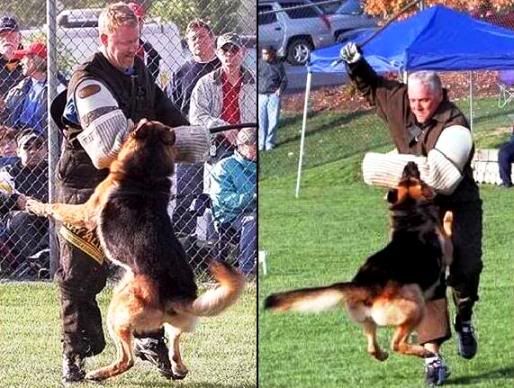
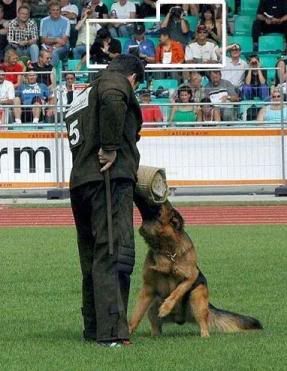
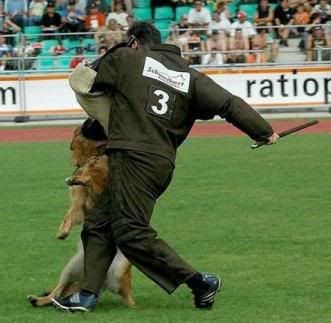
Helper # 5 and handler 1045 shows the 2004 V-1 Karat’s Ulk doing the after-struggle guard from the down position, which is useful to teach dogs that don’t really want to out and then remain so close to the tempting sleeve.
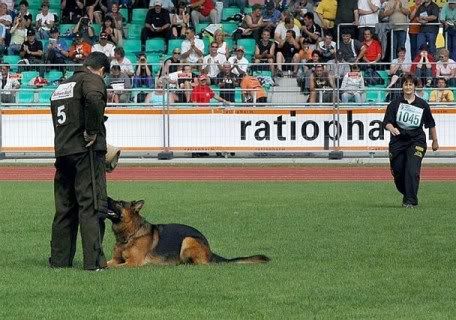
Ulk was pulled before conformation judging in order to give another Karat’s dog a chance at the VA rating, a very unwise ploy, since the second dog did not get higher than V-1 anyway, and Ulk would almost certa
inly have been VA if only they had bothered to get a German breed survey on his dam. Some folks must have been kicking themselves in the rear-end all the way home after that show! Number 1068, Torro Barenwald, is shown in a very nice, correct, attentive guarding mode while the handler comes to pick him up.

Usually these dogs bred strictly for working competitions place far back in the pack… around 110th place or further back. That’s because they are not as highly selected for the proportions, front angulation, long croups, etc. which show-line breeders are always trying to perfect. Most are there to show off (their routines are usually head-and-shoulders above those of the show dogs that get far less practice sharpening their protection skills) or to place highly enough to earn points toward the Universal Sieger title. This is an honor given to high scoring dogs at the annual German and international schutzhund prüfung trials who also do well in the breed ring. In 2005, the judge of the males decided that every dog competing was worthy of a V (excellent) rating, and gave no SG or lower ratings. Of course, that included only those that qualified in the
preliminary courage test.
